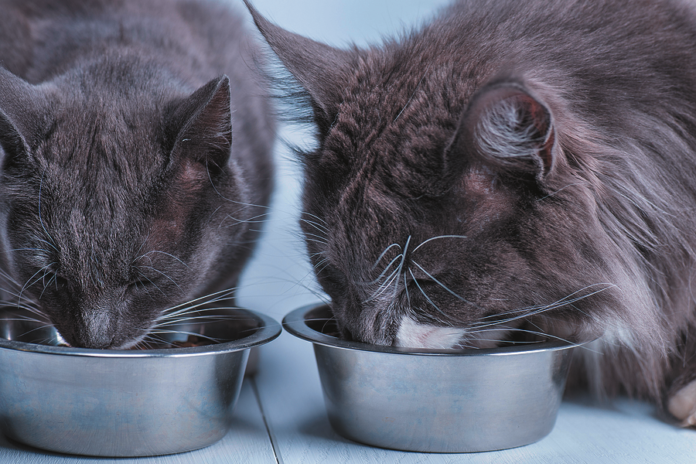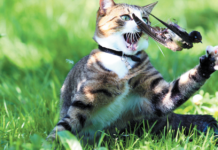Conduct an online search for how often a cat should be fed, and it will yield a surprising array of answers. While most sites agree that kittens need to be fed several times a day to meet their nutrient needs, advice for adult cats runs the gamut, veering from once a day to five times daily. What’s the right answer?
Despite the fact that most people feed their cats only once or twice a day, what’s best is several small meals. And if a cat lives with other felines, she should have the opportunity to eat alone — out of the line of vision of the other pets in the home.
Solitary predators
Left to their own devices in the wild, cats are solitary predators; they prefer to hunt by themselves, says the American Association of Feline Practitioners. Their natural behavior is to hunt prey of low calorie density throughout the day, meaning they engage in several mini eating occasions.
Cats prefer to eat by themselves, too. They are not social diners. It’s the opposite of how most pet cats are fed. They are given relatively large amounts of food just twice daily, or even once. And if there is more than one cat in the household, all the cats tend to be fed in bowls right next to each other. There are some significant problems that develop from these all-too-common feeding methods that cats find unnatural.
Stress. Having to obtain their food in a way that does not feel instinctual will make a cat feel anxious. The added stress does not just have emotional consequences. Stress can actually make a cat sick. For instance, it can lead to cystitis — a bladder inflammation that sometimes requires drugs as part of treatment. Mealtime stress can also result in “issues” at the litterbox, including inappropriate elimination.
Obesity. Having too much food put in front of him at once can make a cat eat more than he’s actually hungry for. It’s boring just to be fed once or twice a day, and bored felines (just like bored humans) might overeat to fill in the time. The overeating, of course, can then lead to obesity, a common cat malady that makes it difficult to engage in the natural feline behaviors of jumping and climbing and can also pave the way for serious illnesses like diabetes, arthritis, high blood pressure, and heart and respiratory disease.
The right way to provide access to food
“The goal of a feeding program should be to mimic the cat’s natural feeding behavior,” say researchers writing in the Journal of Feline Medicine and Surgery. That means cats should be given frequent small meals each day. They don’t provide a number, but two or three times daily is too few.
It’s even better if the cat is provided with food via food puzzles that he has to manipulate with his paws or tongue in order to reach the bounty. That simulates his life going after food in the wild to some degree and has the added benefits of increasing activity (thereby improving weight management) and providing the mental and physical stimulation necessary to keep him on an even keel emotionally.
Another option, in addition to providing meals in food puzzles, is to place fractions of food portions around the house in different locations, including making use of elevated spaces if your pet can climb or jump easily. It makes the “hunt” more interesting.
If there is more than one cat in the house
If you’re a two- or multi-cat household, be sure to feed your pets in separate locations that speak to each one’s comfort level. Cats should be given their food in a spot that they feel safe, without having to look at another cat, if at all possible. That tactic could even help minimize cat-on-cat aggression. Just because cats will eat together doesn’t mean they like to.
You may not always recognize the signs of discomfort about eating around other cats; they include approaching food with caution, ear flattening, or eating while hunched or crouched. All of those postures and gestures mean the cat is being extra-vigilant because of feeling tense.
Never offer food near the litterbox. You wouldn’t enjoy eating by or in the bathroom, and neither do they.
Keep the food and the water in separate locations. Cats see standing water as “stagnant” and therefore having potential contaminants that can taint their food.





My kitty, Zeke, is a 12 1/2 yr. old Champagne Burmese. I acquired him from a woman who needed to give him up due to her health and living circumstances. He was almost 8 at that time. He weights only 8 lbs and loves to eat frequently! I’ve found that he prefers to be played with (chasing cords or ribbons on sticks mostly) before he eats whenever possible. Must be that hunting instinct!! He also insists upon being brushed before dinner time. He can only digest canned food, so he eats 3-4 small cans a day plus 3-4 anti-hairball treats. Also, he does seem to prefer being alone when he eats. Oh, he also has two of his own heating pads since his hair is not very thick. He’s a very healthy and active, personality plus boy!!
I loved hearing all about Zeke! You seem to be very tuned in to him. I try my best to do that for the two litter mates I adopted when they were 8 weeks old. From the very beginning, I allowed Dusky & Shady to “graze” from a kibble-dispensing gravity feeder whenever they were hungry. I figured their appetite would vary, depending on how many times they chased each other around the house or climbed the drapes! I also fed them small portions of wet food a couple of times a day; served in dishes that were placed side by side. They never squabbled over food or seemed uncomfortable in any way with that arrangement, although they do “crouch” while eating, which the article suggested was a sign of discomfort. The rim of their bowls is just 1.25″ high, so isn’t their posture while eating pretty much the same as it would be if they were eating freshly killed prey off the ground? Anyway, now that they’re 3 years old, I’m feeding them mostly wet food; several small portions throughout the day. But their first meal is kibble from an automatic feeder; timed to feed them before I get up, because I’m not a morning person. The 2 servings are dispensed into a single tray that they have to share, so they’re stuck with that. But the next time (or next few times) I serve the wet food, I’ll place their bowls in different parts of the kitchen, where they can’t see each other, and look for any change in approach or attitude. Couldn’t hurt to experiment, right?